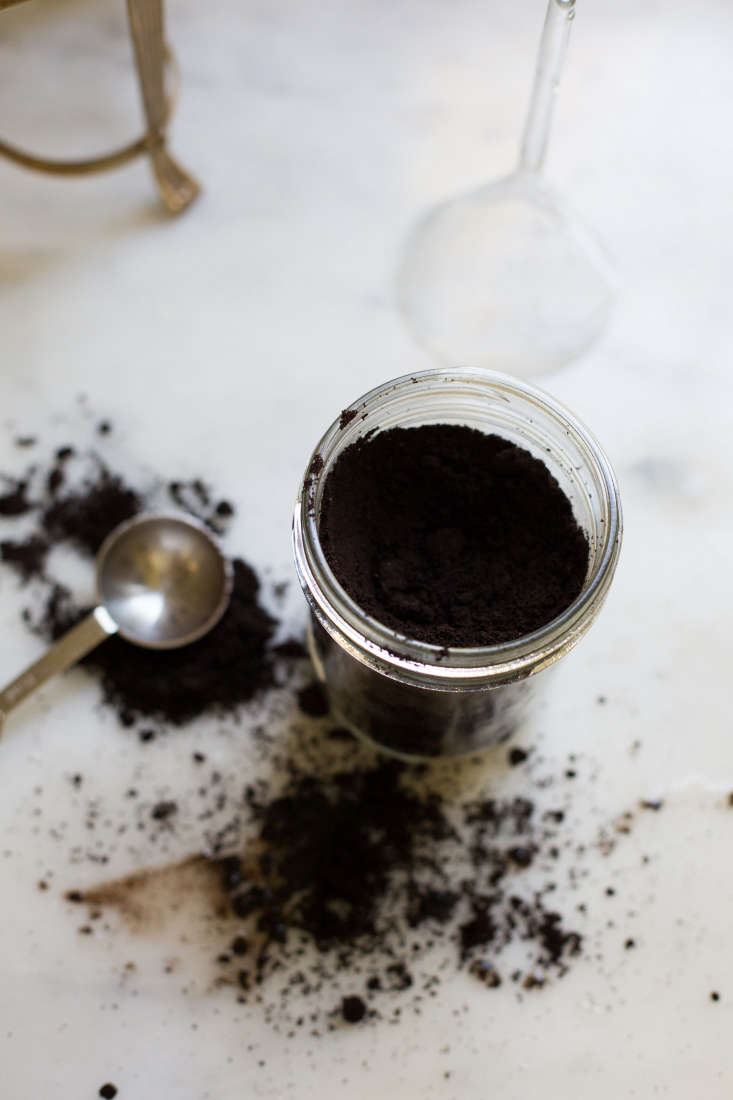If you’re not a paid subscriber to Gardenista and Remodelista, you’re in for a treat this month. Every Sunday until the end of the year, we’re opening up Quick Takes content—normally reserved for subscribers—to everyone. (You can learn more about Quick Takes here. And sign up for a paid subscription by clicking “Join” in the upper right corner of the homepage.)
Today, we’re sharing our Quick Takes experts’ best gardening hacks. Got a slug problem? There’s a fail-proof low-tech solution hiding in your fridge. Want to make your cut flowers last longer? Our pros have just the answer. Interested in planting according to the lunar cycle? At least a few of our experts would say, Go for it!
Read on to learn their favorite tricks for a thriving, pest-free landscape.
For the Soil:

Coffee grounds. I drink a lot of coffee and am able to have a constant supply of fertilizer. Also, cover your perennials with their own dead leaves in the fall to add protection against excessive rainfall and cold weather. —Molly Sedlacek
Using used coffee grounds and fireplace ashes as amendments. —Christopher Crawford
Throwing my coffee grounds out to add acid to our alkaline soil. Also letting the leaves stay in planting beds as mulch. —Christine Ten Eyck
The lasagna layering method for preparing new garden beds has done wonders for our soil condition and backaches. —Alan Calpe
Place pennies alongside your roses for good fortune and health. (The copper from the pennies adds nutrients to the soil and prevents fungus in roses.) —Molly Sedlacek
Plant Tone. Organic fertilizer is something we are using less and less of, but sometimes the soils in these Brooklyn backyards are so depleted of anything organic, that Plant Tone really helps. We discourage people from spreading it around when doing a new plant installation, it tends to shock the plants, but it’s a good thing to add after the plants have taken hold a bit, and mostly in the spring. We stay away from fertilizing in the fall—we don’t want to promote new growth. But, with climate realities sinking in, even the sense of how long to fertilize becomes a challenge. The norms are no longer relevant. —Corwin Green
For the Plants:

My grandmother, who worked on a dairy farm her entire life, would say that the best time to plant flowers is during the waxing moon, which is the time between the new moon and the full moon. And it’s true! When planting seeds I can literally tell they shift in the soil overnight, I used to think it was about gravitational pull, but apparently it is about the increase in light overnight. This increase in light increases sap flow. Farmer’s Almanac promotes that the “the waxing moon is a good time to plant annuals, biennials, and flowering plants that produce above-ground crops.” And I believe them—and I believe my grandma! —Damon Arrington
I’m not entirely sure it actually works but every season, I organize my seed sowing following the lunar calendar—sowing seeds during the new moon phase and avoiding doing so in the last quarter of the month. It feels significant to align my growing to the practices of our ancestors. —Claire Ratinon
The Chelsea chop. Literally hacking some plants can revive them. —Deborah Needleman
A simple “Russian doll” planting technique: Use the dappled shade from your apple tree to grow blueberries, then use the dappled shade from your blueberries to grow alpine strawberries. If you’re still feeling adventurous, add yerba buena (delicious herbal tea) for your final layer. —Christian Douglas
Crates. Upside-down vegetable or other ventilated crates help take the “edge off” sudden downpours/hail/extreme heat. They also help “mark” emerging planted or special areas, can be moved around to suit seasonal needs, and stack well in storage. —Tama Matsuoka Wong

Plunging small pots in large buckets of water through out the summer, it’s the quickest best way to water them. —Butter Wakefield
I love the technique of what I call “half pruning” flowering perennials like yarrow, nepeta, or even larger hydrangeas to keep the garden looking more floriferous and full while still cutting things back before they get too tired. When a plant needs to be pruned back but I don’t want it to be gone entirely from my garden view for so long, I’ll cut back half of the plant hard and give that side a few weeks to grow back in a bit, before I cut the other side. That way, I have some of the older blooms lasting longer in the garden, but I get a head start on the new regenerative growth and fresh flush of blooms on their way. —Leslie Williamson
Using my electric hedge shears to buzz down and clean up perennial grasses and the previous years’ perennial remnants in the spring. After many years of gardening, its nice to give your pruning hand a break. —Todd Carr
One pearl of wisdom from my victory-gardening father is to pluck the flowers from potato plants for bigger harvests. He’s been providing potatoes for our family roast dinners for 50 years! —Christian Douglas
My grandmother always overwintered the geraniums (Pelargoniums) she grew in pots each summer by bare-rooting them, then hanging them upside-down in paper bags pinned to a clothes line in her dark, cool cellar. —Margaret Roach
For the Weeds

Plant densely to avoid weeds, plant diversely to bring life. —Summer Rayne Oakes
Thick layers of cardboard for weed-block starting new beds. —Fritz Haeg
For the Pests

Slugs do love beer. I’ve used crushed shells, copper rings, and sheep’s wool, but beer traps still seem to be the only effective and foolproof mollusc deterrent. —Dan Pearson
Those beer traps for slugs really do work! We use them all the time in our client veggie beds. —Leslie Williamson
The best way to get rid of slugs without harming other wildlife really is to put a few bricks around the garden and then gather and dispose of the slugs that have gathered on the bottom of the brick. —Flora Grubb
Kitty litter in your gopher holes. —Taylor Palmer & Anastasia Sonkin
Growing marigolds with tomatoes to helps enrich the soil and deter pests; cardboard to suppress weeds when laying in new gardens. —Alex Bates
My friend Connie taught me a natural spray for roses and citrus: juice of 2 lemons, 2 tablespoons of potassium, 2 tablespoons of cayenne or cinnamon, 1 liter of water—and spray over the leaves. Good for fungus and bugs. —Frances Palmer
For the Gardener
Sheets of fabric softener tucked into a garden hat or the neck of your shirt to ward off bugs. —Christopher Crawford
Keep an old toothbrush handy to clean the soil and gunk out of your harvest knife and secateurs after a busy day of growing. —Claire Ratinon
David: I have a bathtub in my garden and I use it to water my Sycamore Trees (which like a bit of water). Feels like a solid hack to me. —David Godshall
For Cut Flowers

I’ll offer a cut flower tip: boil your stems. After a fresh cut, a minute in boiling water will revive and prolong the life of many (nay, most) stems. —Emily Thompson
Hot-water dipping cut flowers. I have an electric tea kettle I keep in my flower studio for submerging the stems of poppies and other plants. Just a ten second dip in boiling water or so can make a real difference in terms of a flower’s vase life. —Christin Geall
You should put flat lemonade in your cut flower water. This has citric acid and carbonic acid (CO2 in liquid forms weak acid). By changing pH you decrease bacterial reproduction and enable the flowers to last longer. —Sarah Raven
See also:
- Kitchen to Garden: 6 Common Household Ingredients to Use for Healthier Soil and Plants
- 5 Genius Gardening Tips I Learned from TikTok
- Landscaping: 10 Clever Gardening Tips to Save Time
- And for our archive of Quick Takes, go here.












Have a Question or Comment About This Post?
Join the conversation (0)